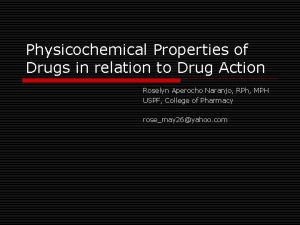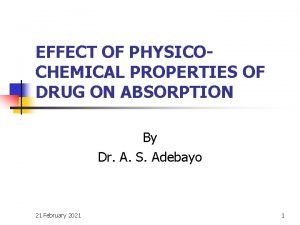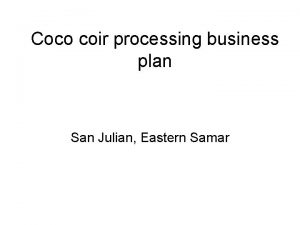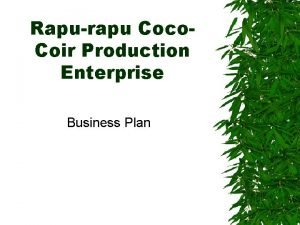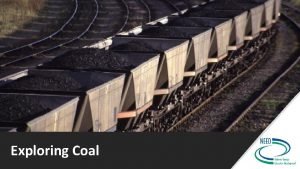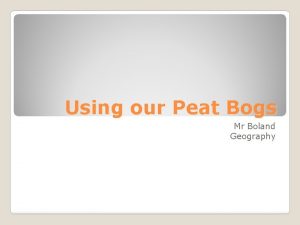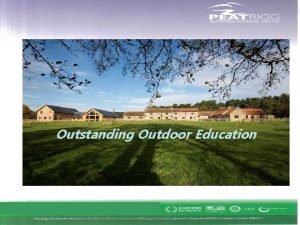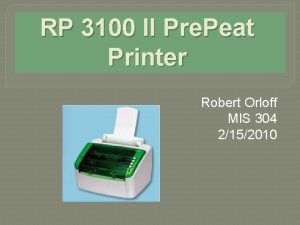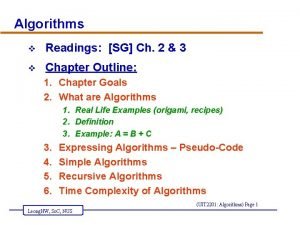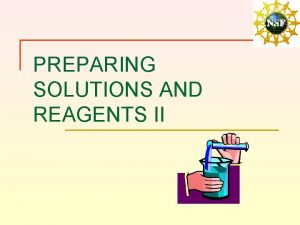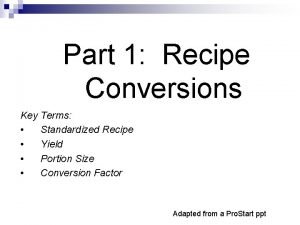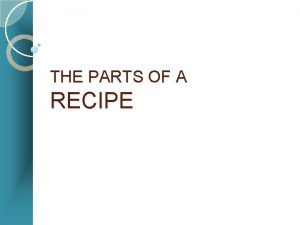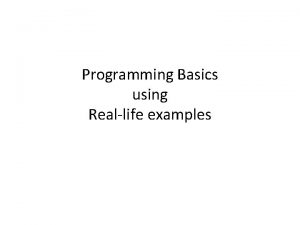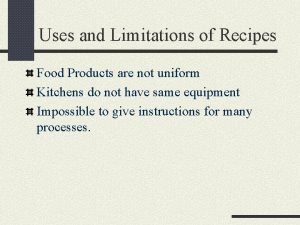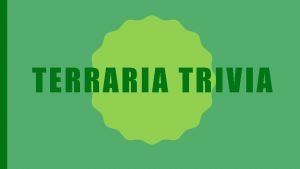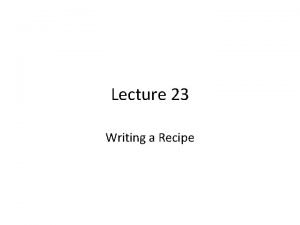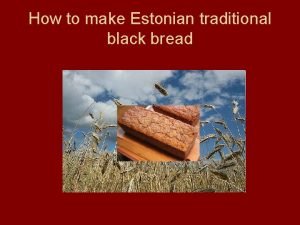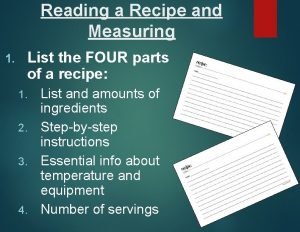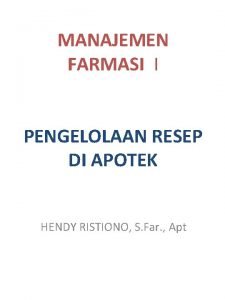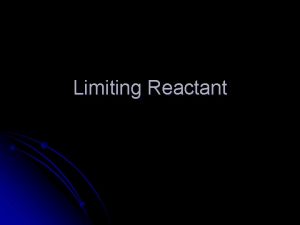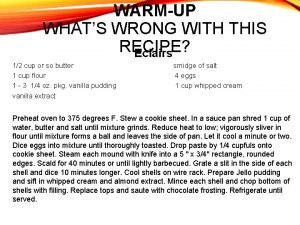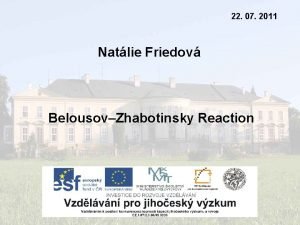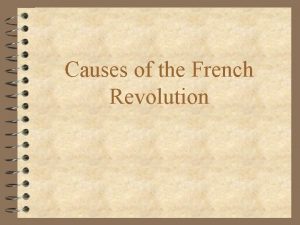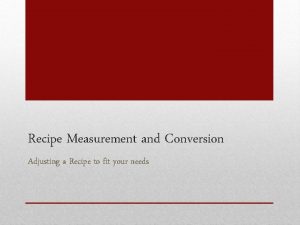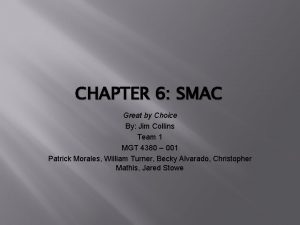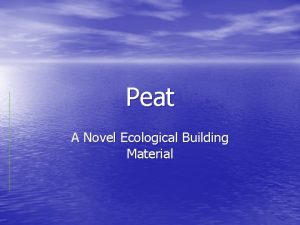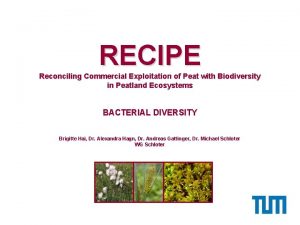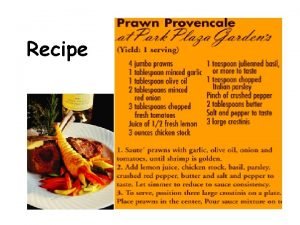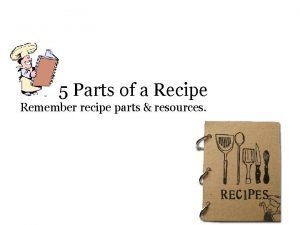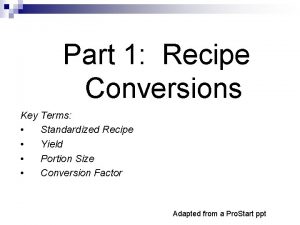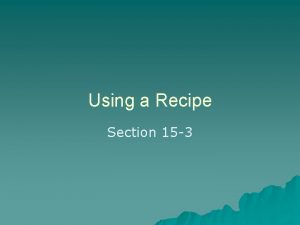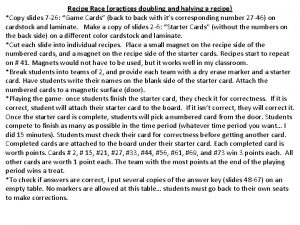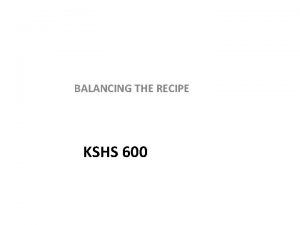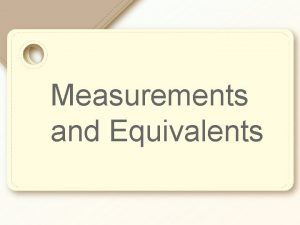WP 05 physicochemical quality of peat OM RECIPE





















































- Slides: 53

WP 05: physico-chemical quality of peat OM RECIPE meeting May 29 th-31 th Aberdeen, Scotland D 18: Physico-Chemical characterisation of the Organic Matter (OM) - ISTO

WP 05: physico-chemical quality of peat OM RECIPE meeting May 29 th-31 th Aberdeen, Scotland D 18 - WP 1 1: Bulk indicator: micromorphology 2: Bulk indicator: C/N (bulk peat and fine-grained fraction) 3: Molecular indicator: sugars fine-grained fraction) (bulk peat and

1. Bulk indicator: Microremain counts New regenerating peat AOM Muc Pol. Er. Sp. AOM Muc All sites pooled AOM Muc Sp. Pol. Sp. Er. 1) Heterogeneous inherited tissues tend to become more homogeneous (dominance of Sphagna) 2) Increase of percentages of humified materials and microbial secretions. Old peat Muc AOM Composed of - microbial secretions - humified materials - structureless tissues

1. Cryo. SEM: Texture of Le Russey bulk peat Evolution of the bare peat surface along a trend of regeneration Eriophorum species Bare peat FRA FRB - Bare peat => Impact of the exploitation 5µm New peat (25 years) FRC Intact FRD - Texture at 25 yrs ≈ intact 5µm Higher biodegradation in early regenerating stages than in the advanced ones

1. Cryo. SEM: Microorganisms (Le Russey) SURFACE 12µm 10µm 3. 75µm - At surface peat => high diversity, high abundance Same diversity in November 2001, 2003 and June 2005 DEPTH 3µm 2µm - At depth => low diversity (bacteria), low abundance

2. Bulk indicator: atomic C/N bulk Baupte Jura sites Finland Scotland 5 -10 years - C/N of FI & SC > FR+CH > FB -in upper level: 20 < C/N < 40 - downward: 40 < C/N < 60 3 : 2. 5 cm 6 : 25 cm 4 : 7. 5 cm 8 : 45 cm 25 -45 years Boundary between old and new peat Intact and > 50 years Higher C/N in regenerating peat (25 and 50 years) showing effect of regeneration on bulk chemical characteristics of peat

3. Molecular indicators: Total sugars Baupte Jura sites Finland Scotland Fine-grained fraction < 200 µm (strong hydrolysis) 5 -10 years mg/g 3 : 2. 5 cm 6 : 25 cm 4 : 7. 5 cm 8 : 45 cm 25 -45 years mg/g Intact and > 50 years High total sugar content, except for FB No difference between recent and advanced regeneration stages: Recent regenerating stage => TS 200 mg/g In advanced stage => TS 200 mg/g but within a profile total sugar content can reflect the difference between « new » and « old » peat

WP 1: Recording of source materials in a regeneration trend (mg g-1) at the Scottish site 63 µm < fraction < 200 µm (weak hydrolysis) rhamnose and galactose are markers of Sphagnum species xylose and arabinose are markers of Vascular plants Analysis of sugars can record influence of both plants

WP 1: Evolution of 2. 5 cm microremains during regeneration at the Scottish site Dominance of Bare peat 5 years 7. 5 cm mucilage in bare peat Increasing amount of preserved Sphagnum tissues (low AOM) Eriophorum 10 years 0 cm 25 cm 2. 5 cm 45 cm Sphagnum 10 years 7. 5 cm Mixed vegetation 50 years 25 cm 45 cm 7. 5 cm 45 cm 25 cm Microremans reflect input from both vegetation as sugars 45 cm Dominance of AOM and unspecified tissues

WP 1: Influence of the water table on sugar content (%) in wet and dry Eriophorum situations in Finland (weak hydrolysis) 63 µm < fraction < 200 µm *Relative amount of sugars originated from the plant, Xyl and Ara, are lower in dry conditions than in wet conditions (higher Hemi Glu) * # * Analyses of sugars are able to reflect chemical changes of peat induced by rewetting: higher degradation of the litter in dry conditions # Microbial markers: -Fucose more abundant in wet situation than in dry situation -Rhamnose and mannose more abundant in dry situation * # Can relative sugar content reflect changes in microbial communities structure after rewetting? ? *

WP 1: Influence of time on sugar content (%) in Sphagnum fallax situations in Scotland (weak hydrolysis) 63 µm < fraction < 200 µm Compared to Eriophorum, sugar content of peat tend to be similar to the composition of the source material Better preservation of Sphagnum than Eriophorum

Work Program 1: D 18 Physico-chemical characteristics of peat: differences between « old » and « new » peat => The « old » humified peat shows distinctive properties characteristic of an intensive degradation of OM, such as: - Large amounts of amorphous OM and mucilage. - High compaction (bulk density > 0. 15 g. m-3), - Lower C/N ratios (20 -30). => Indicators of the new regenerating peat show: - Microremains dominated by preserved tissues, especially from Sphagnum - Low compaction (bulk density < 0. 05 g. m-3) - Higher C/N ratios (30 -45)

Work Program 1: D 18 Physico-chemical characteristics of peat: dynamics of OM quality Microremain counts in new peat showed -1) deacrasing relative amount of preserved tissues, with more homogeneous peat in advanced stages (Sphagnum less degraded than Eriophorum) -2) increasing relative amount of humified materials Molecular analysis showed -1) vegetation contribution to chemical composition of OM during regeneration -2) effect of rewetting on OM chemistry (less source markers, more hemi G in dry conditions) Schematic model of peat evolution of chemical characteristics from new to old peat in the different sites 3 trends : Jura sites, Scottish sites, Finish sites - Similar 1 st steps of regen. for Jura & Scotish sites => similar plant compositions of new peat (mainly Sphagna) 21% - Distinct evolution for F => « litter » composition in Finish sites is quite different (C. ros, E. vag) 33% - The old peat evolution of SC & FI sites converge with the same variables which characterise a more humified peat

WP 05: physico-chemical quality of peat OM RECIPE meeting May 29 th-31 th Aberdeen, Scotland D 18 – WP 2 CNS results Sugars analysis results

1. Bulk indicator: site effect on C/N Chemical characterisation of the peat from each site: Le Russey: Scotland: Finland: Baupte: higher C%, lower N% and S% higher C%, intermediate N% and S% Lower C%, higher N% and S%

1. Bulk indicator: C/N depth effect Tend to increase with depth Higher N content at the surface Tend to decrease with depth

1. Bulk indicator: water table (WT) and vegetation (Veg) effect Kruskal Wallis testing main effects - In all sites: Veg had no significant effect on N%, but: Le Russey Baupte -In Baupte and Finland: -In Scotland Le Russey: WT no significant effect on C% WT significant effect on C% (other than low situation at FR, tend to increase with WT - In Baupte and Scotland: -In Finland Le Russey: Veg no significant effect on C% Veg significant effect on C% (FR: low in Ev and high in Sf, FI: high in Ea and low in SF)

1. Bulk indicator Bulk analyses were able to: - show site and depth effect on C/N - record effect of water table and vegetation on C% in spite of the short period of study Response of C and N content to water table and vegetation seems to depend on peat type (site characteristics) and history of exploitation Finland Le Russey Baupte Scotland Increase of sensitivity to treatments

2. Sugar analysis: FI low water table – 12. 5 cm Hot water extraction versus weak hydrolysis – extract the most labile sugars newly synthesized % 1) Compared to bare peat, E. vag tended to increase the proportion of sugars derived from microbial synthesis and/or root exudates 1) % 2) Under S. fal, among the microbe markers, only fucose tended to increase slitghtly (rhamnose is also a marker of Sphagnum sp) % Analysis of hot water extractable sugars detects changes caused by plant colonisation better than weak hydrolysis 2) Weak hydrolysis Hot water extraction Impact of plant on microbial activity?

2. Sugar analysis: problem encountered November 2005 IS R A X+F IS M G Ga G Appearance of many unknown peaks March 2006 IS IS Hot water extractable sugars are very sensitive to storage condition Disappearance of known peaks

2. Sugar analysis: vegetation effect on glucose (µg g-1) In other sites than Baupte, Eriophorum situation tend to contain more hot water extractable glucose E. ang in Le Russey and Scotland E. vag in Finland Plant effect may differs between site in long term?

2. Sugar analysis: water table effect on glucose (µg g-1) In other sites than Baupte, water table tend to affect hot water extractable glucose Increase with WT in Le Russey and Scotland Decrease with WT in Finland Site may respond differently to water table in long term?

2. Sugar analysis: depth effect on glucose (µg g-1) Trend of hot water extractable glucose with depth tend to be different between site Decrease with depth in Le Russey and Scotland Constant in Finland Spatial distribution of hot water extractable glucose differs between site in long term?

2. Sugar analysis: synthesis Results difficult to interpret because: - difficult to know if the glucose was from plant or microbial origin -difficult to know how much is consumed versus how much is produced: very sensitive marker - methodological difficulties (storage) - time of experiment may be too short to produce significant differences on the peat chemistry

2. Sugar analysis: synthesis HOWEVER - hot water extraction revealed to be a good method to detect sugars from microbial or plant exudates origin compared to weak hydrolysis (on bulk material or size fractions) - similarities / differences between sites Scotland / Le Russey Finland Baupte

WP 1 and WP 2 General synthesis Age effect Microremain counts In the first stages, vegetation dominated by Eriophorum (FR, FI) BUT heterogeneous underlying new peat. In advanced regenerated stages, mixed vegetation BUT homogeneous underlying new peat (derived Sphagnum tissues). Difference of decomposition rate between plants remains is highlighted by microremain counts This is confirmed: 1) at Le Russey, by Cryo SEM with the observation of more degraded tissues in early than advanced stages at the same depth (WP 1), 2) at the Finnish site, with sugars analysis => higher preservation of Sphagnum than Eriophorum (WP 1), 3) N% tend to be higher under Eriophorum in FR, FI and SC at the surface => potential higher microbial activity (WP 2). Change of chemical composition with regeneration In SC (WP 1), sugar analyses were able to show changes of peat chemical characteristics induced by plant inputs. Depending on the history of exploitation and bare peat composition, revegetalisation may affect peat chemical composition: -at a different rate (different sensitivity to changes of water table and vegetation, WP 2) -in a different manner? (different impact of a same vegetation depending on site, WP 2)

Site effect Results of both WP 1 and WP 2 separated Baupte from the other sites (lower C/N and total sugar content), clearly separating this site in terms of the degree of decomposition of their peat WP 1 results on old peat grouped SC and FI sites with higher C/N than the Jura sites. This difference tend to disappear in regenerated peat (cf Jura sites and SC). The similarity in the first regeneration stages regeneration tend to be confirmed by the sugar analysis of the WP 2, where the peat of Le Russey and Scotland seem to respond in a similar way to treatments Depth effect -WP 1: C/N, sugars and micromorphology: differenciation of new/old peat. Micromorphology and sugars analyses brought more detailed information on the quality of the regenerating peat than C/N Water table effect -WP 1: in wet conditions, better preservation of OM under a same vegetation (sugar distribution in FI). This is confirmed by the higher C content.

Involvement of OM characterisation in the process of exploited site rehabilitation 1) Characterisation of the exploited site Bulk analysis Microremains analysis Sugar analyses 2) Definition of a reference system (carbon storage) 3) Assess the gap between site to manage and reference system 4) Choice of management As bulk analyses such as C/N do not provide detailed informaton on peat quality As sugar content maybe too expensive to implement Bulk analysis Microremains analysis Sugar analyses 5) Survey Microremain counts is the best technique to characterise the OM of a site and undertake survey

And many thanks to those who participated to RECIPE at ISTO: Laure Comont, Christian Défarge, Jean-Robert Disnar, Pascale Gautret, Sébastien Gogo, Marielle Hatton, Fatima Laggoun, Nathalie Lottier and Amélie Fleury (1 year) Also student trainees: Li Huang, Joséphine Vicelli

Problems encountered in the interpretation of OM data WP 1 Too low number of samples in regenerated peat (sample 3 missing in some cases) Lack of reference situation in Baupte, Finland Scotland Reference situations of Jura sites were not studied by all partners of the consortium WP 2 Short time of experiment + many factors interacting Þ Difficult to highlight differences in the peat chemistry Peat substrate reactivity: lack of control that could separate input from plants and reaction of these inputs with the microbial community (sterilised substrate used as control)

1. Micromorphology : OM diagenesis An example of le Russey site: transverse section of Sphagna stems in below litter compartmen 0 -5 yrs – Eriophorum FRB 25 yrs – Mixed vegatation FRC 37. 5µm fine cell walls with empty cavities Intact FRD 20µm 27. 3µm Intermediate degradation stage Thick well-preserved cell walls with filled cavities more rapid peat degradation in the first regenerating stage than in the advanced stage

2. Bulk indicator: C/N – Bulk/Fine fraction 5 -10 years Baupte Scotland Jura (Intact) Scotland Finland : 50 years Finland 140 No differences of the C/N ratio between these both fractions 120 100 C/N Jura 50 years 80 60 40 20 0 bulk <200 µm

2. Bulk indicator: C/N – diverse fractions 5 -10 years Finland 50 years Finland Significance differences in Scotland

3. Molecular indicators: Total sugars An example of le Russey, comparaison of sugars in bulk peat and in the fine-grained fraction <200µm 25 years Intact > 50 years % %

WP 1: Evolution of peat granulomtry during regeneration (mg g-1) at the Scottish site Increase of the coarsegrained fraction in both vegetation compared to bare peat Increase amount of coarse-grained fraction when both plants (mixed vegetation) are allowed to interact for a long time

WP 1: Influence of the water table on sugar content (mg g-1) in wet and dry Eriophorum situations in Finland 63 µm < fraction < 200 µm 1) Sugars markers of vascular plants are consumed in dry situation, whereas they tend to be conserved in wet environment 2) Microbial markers: -Fucose more abundant in wet situation than in dry situation -Rhamnose, mannose and glucose more abundant in dry situation Analysis of sugars are able to track changes in microbial communities structure and activity? ?

WP 1: Influence of the water table on the peat granulometry in wet and dry Eriophorum situations in Finland Coarse grained fraction is found in higher amounts in wet conditions than in dry conditions Water table affect the peat granulometry reflecting degradation processes

WP 1: Influence of the water table on Global similar macrorest profile between the two situation the macrorests Eriophorum wet Eriophorum dry 0 cm 2. 5 cm 0 cm Poor indicator of water table effect 2. 5 cm 7. 5 cm 25 cm 45 cm

ISTO in the WP 2 - Chemical characterisation of the peat from the different situations with different approaches Aim: determine the effects of site, vegetation, water table and depth on chemical properties of peat Integration with other results: definition of indicators of carbon sequestration

ISTO in the WP 2 Level of analysis Analysis (method) Samples analysed Aim All samples from all sites: Bulk characteristic CNS (LECO) Characterizatio n + effect of treatments on 432 subsamples bulk analysed for C, characteristics N and S One profile from each situation Molecular approach carbohydrates (hot water extraction - GC) 144 subsamples analysed for sugars content Effect of treatments on sugar content of peat in early regeneration stage

1. Bulk indicator: C% water table effect - In Baupte and Finland: water table had no significant effect on C% - In Scotland Le Russey: water table had a significant effect on C% Finland Le Russey Ea +Sf? Baupte Scotland

1. Bulk indicator: C% vegetation effect - In Baupte and Scotland: vegetation had no significant effect on C% Scotland Baupte - In Finland Le Russey: vegetation had a significant effect on C% Le Russey Finland

1. Bulk indicator: N% vegetation effect - Vegetation had no significant effect on N% in all sites Scotland Baupte Le Russey Higher in Primary surface production? peat Finland

1. Bulk indicator: N% Le Russey vs Baupte

2. Sugar analysis Method: As the substrate is rich in sugars, a different method than those used in the WP 1 (weak and strong hydrolysis of peat on fine fraction) had to be developed in order to illustrate possible treatment effects at the molecular level. Puget et al. (1999) showed, in mineral soils, that a hot water extraction of carbohydrates followed by an acid hydrolysis could be used to detect monosaccharides originated from microorganisms. This was the first attempt to adapt this method to peat.

2. Sugar analysis: weak hydrolysis vs hot water Low water table % 1) Increased proportions of Fucose, Allose, Rhamnose, Ribose: microbe marker 2) Lower proportions of xylose: vascular plant marker Hot water extraction has a better potential than weak hydrolysis to detect treatment effects

2. Sugar analysis: results of glucose (µg g-1) Hot water extractable Glucose between sites Hot water extraction is able to detect site differences with the most intensively exploited site, Baupte, containing the lowest amount of hot water extractable glucose

-WP 2: C/N increase with depth at FR and FB and decrease with depths at FI and Sc due to relative high N at the surface of French sites (Vegetation at Le Russey and allochtonous input in Baupte? )

D 16 Experimental assessment of decomposition kinetics Protocol to study the fate of organic C and N in the peat using labelling technics (WP III) Principle : - peat columns in laboratory experiment with 15 N-13 C labelled litters - peat columns in field experiment with 15 N-13 C labelled litters - 3 plant litters - Sphagnum fallax (mixture of capitula + stems and leaves) - E. vaginatum - E. angustifolium WP 3 Litter bag system in the field : The labelled litters were dried and inserted in fine-meshed litterbags that covered the whole surface of the pots that were put in the experimental trenches. The in-situ insertion was started between mid-July and beginning of August. Because of the lack in litter, new plants had to be grown to get enough litter material. fiber glass nets (= anti-mosquito curtain) with a 0. 5 mm mesh size : 2 nets on upper and below openings (upper and below parts of the 5 cm height PVC cylinder) PVC ring (about 5 cm height) : adjusted at the surface of the peat column inside the PVC tube (see black arrow) - 3 replicates (3 trenches) for · 3 plant litters · 3 water levels - harvest date : 12 months after in situ incubation starting (July-August 2004) peat surface in the trench PVC tube in the field (trenches), filled with peat

Litter system in the lab : Conditions of incubation : 16/8 hours day/night photoperiod 80 % humidity air saturation Air temperature : 18°C day, 12 °C night Device : Cap of the jar with a septum in the middle fiber glass nets : see upper Litter adjusted at the surface of the peat column inside the PVC tube (see black arrow) Water-level in the jar 10 cm height PVC tube in a jar with peat from Le Russey fiber glass net 6. 5 cm diameter

Labelled litter 13 C - 15 N Peat column Harvest dates - laboratory experiment : 15, 60 and 180 days (6 months) after initiation of incubation Measurement of CO 2, CH 4, N 2 O emissions - at 1, 2, 5, 7, 15, 60 days - directly in the jar by clapping the cap and sampling through the septum as following : towards microbes Microbial communities : 13 C PLFA analysis 13 C & 15 N in microbial towards peat biomass 15 N mineralization & 15 N (K 2 SO 4 extract without fumigation) 13 C Gas Chromatograph Compartments which should be analysed in the field experiment : - litter, peat layers 0 -5 cm, 5 -15 cm, 15 -25 cm For each depth : soluble organic matter in K 2 SO 4, microbial biomass, peat stock, mineral N 13 C PLFA microbial communities (Münich),

Preliminary results on N transformations (lab experiment) 15 N method – Calculation of the N recovery For each selected compartment (peat, N mineral, microbial biomass, etc. ), the recovery from the N input is calculated as : % R = (Ei/Eo) * (Ni/a) * 100 with Ni = N stock of the compartment i a = N mass of the input (litter at the start of the experiment) Ei = isotopic excess of the compartment i Eo = isotopic excess of the input Ei/Eo corresponds to the N proportion coming from the labeller. This corresponds to what is called Ndff (Nitrogen derived from fertilizer (Powlson & Barraclough 1993, Guiraud & Boniface 1987)

 Physicochemical properties of drugs
Physicochemical properties of drugs Physicochemical properties of drugs
Physicochemical properties of drugs Local guide program
Local guide program Coir business plan
Coir business plan Formation of coal
Formation of coal Burwardsley residential centre
Burwardsley residential centre Peat moss for puraflo
Peat moss for puraflo Peat geography definition
Peat geography definition Puraflo peat
Puraflo peat Peat rigg rooms
Peat rigg rooms Estonian peat cake
Estonian peat cake Pmp quality management
Pmp quality management Quality management gurus
Quality management gurus Pmbok quality assurance vs quality control
Pmbok quality assurance vs quality control Quality is free: the art of making quality certain
Quality is free: the art of making quality certain Quality improvement vs quality assurance
Quality improvement vs quality assurance Quality improvement vs quality assurance
Quality improvement vs quality assurance What is tqm
What is tqm Quality control and quality assurance
Quality control and quality assurance Basic concepts of quality
Basic concepts of quality Algorithm recipe example
Algorithm recipe example Grey peas and bacon recipe
Grey peas and bacon recipe A recipe for meaningful gamification
A recipe for meaningful gamification Halving a recipe
Halving a recipe Action recipe example
Action recipe example Sm buffer recipe
Sm buffer recipe What is a recipe category
What is a recipe category What are the 7 parts of a recipe
What are the 7 parts of a recipe To combine two mixtures by gently cutting down
To combine two mixtures by gently cutting down 5 parts of a recipe
5 parts of a recipe Identifying parts of a recipe worksheet
Identifying parts of a recipe worksheet Pseudocode recipe
Pseudocode recipe Standardized recipe example
Standardized recipe example Hellstone bar
Hellstone bar Algorithm for baking cookies
Algorithm for baking cookies Think about
Think about Lecture recipe
Lecture recipe Estonian black bread recipe
Estonian black bread recipe Foodafactoflife costing a recipe
Foodafactoflife costing a recipe Gloria dump punch recipe
Gloria dump punch recipe Standardized ingredients culinary definition
Standardized ingredients culinary definition What are the eight steps to following a recipe correctly
What are the eight steps to following a recipe correctly Recipe management system
Recipe management system How to figure out the limiting reactant
How to figure out the limiting reactant What is wrong
What is wrong Belousov-zhabotinsky reaction recipe
Belousov-zhabotinsky reaction recipe Serbian easter recipes
Serbian easter recipes Food a fact of life costing a recipe
Food a fact of life costing a recipe French revolution recipe
French revolution recipe Narrative form recipe
Narrative form recipe Adjusting a recipe
Adjusting a recipe Recipe poems examples
Recipe poems examples Narrative form recipe example
Narrative form recipe example Smac recipe
Smac recipe
